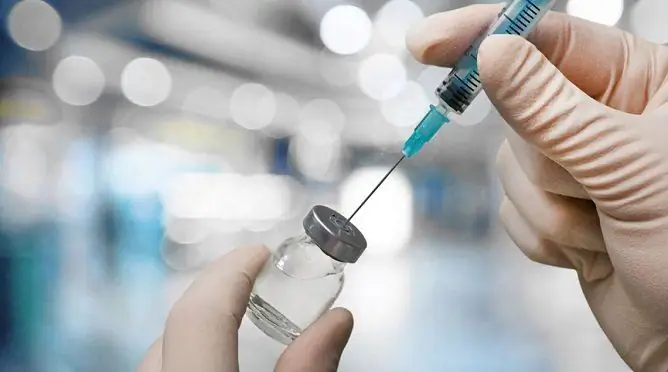- Author Rachel Wainwright [email protected].
- Public 2023-12-15 07:39.
- Last modified 2025-11-02 20:14.
Regevak B
Latin name: Regevac B
ATX code: J07BC01
Active ingredient: vaccine for the prevention of viral hepatitis B (vaccine Hepatitis B)
Manufacturer: CJSC "Binnopharm" (Russia)
Description and photo update: 2019-05-12

Regevac B is a liquid recombinant hepatitis B yeast vaccine.
Release form and composition
Regevak B is produced in the form of a suspension for intramuscular administration - a white homogeneous suspension with a grayish tint, which does not have visible foreign particles; after settling, it separates into a transparent supernatant liquid and a white with a grayish tinge precipitate, which is easily resuspended by shaking:
- suspension for intramuscular administration with a dosage of 10 mcg / 0.5 ml (1 dose for children): 0.5 ml in glass ampoules, 5 ampoules in blisters, in a cardboard box 1 or 2 blisters; 0.5 ml in sterile disposable syringes of a neutral color, 1 or 3 syringes in blister packs, in a cardboard box 1 blister pack with 1 or 3 syringes, or 2 blister packs with 3 syringes;
- suspension for intramuscular administration with a dosage of 20 μg / 1 ml (1 dose for adults): 1 ml in glass ampoules, 5 ampoules in blisters, in a cardboard box 1 or 2 blisters; 1 ml in sterile disposable syringes of a neutral color, 1 or 3 syringes in blister packs, in a cardboard box 1 blister pack with 1 or 3 syringes or 2 blister packs with 3 syringes).
Each pack also contains instructions for using Regevac B.
Composition for 1 adult dose (1 ml):
- active substance: purified surface HBsAg (hepatitis B virus antigen) - 20 μg;
- auxiliary components: aluminum hydroxide sorbent, thiomersal preservative (or does not contain), components of a buffer solution (sodium hydrogen phosphate, sodium chloride, sodium hydroxide to pH 6.95-7.05, sodium dihydrogen phosphate dihydrate, water for injection).
Composition for 1 baby dose (0.5 ml):
- active substance: purified surface HBsAg (hepatitis B virus antigen) - 10 μg;
- auxiliary components: aluminum hydroxide sorbent, thiomersal preservative (or does not contain), components of a buffer solution (sodium hydrogen phosphate, sodium chloride, sodium hydroxide to pH 6.95-7.05, sodium dihydrogen phosphate dihydrate, water for injection).
Pharmacological properties
Pharmacodynamics
Regevak B is obtained by DNA recombination on a yeast culture of Hansenula polymorpha. Yeast DNA is transformed by inserting a gene into the genome that encodes the surface antigen of the hepatitis B virus. Thus, the vaccine is a preparation based on surface HBsAg.
As a result of the course of vaccination, more than 90% of vaccinated people develop specific antibodies to the hepatitis B virus.
Pharmacokinetics
There is no data.
Indications for use
The Regevac B vaccine is used to prevent hepatitis B in the following groups of people:
- children (this vaccine is included in the national vaccination schedule);
- healthcare workers who come into contact with the blood of people with hepatitis B virus;
- persons who have come into contact with material that has been infected with the hepatitis B virus;
- persons with an increased risk of infection with the hepatitis B virus (hematological patients; children from orphanages, boarding schools and orphanages; adults and children in whose families there is a patient with chronic hepatitis B or an HBsAg carrier; patients on hemodialysis; adults and children, regularly receiving blood and its preparations from donors);
- students of secondary medical schools and students of medical universities (primarily graduates);
- persons engaged in the production of immunological preparations from placental and donor blood;
- people who use drugs (by injection).
It is recommended to vaccinate all other populations not included in the above.
Contraindications
Absolute:
- exacerbation of chronic diseases, infectious and non-infectious diseases in the acute stage (it is recommended to carry out immunization not earlier than 1 month after remission or recovery);
- children under 1 year of age (for a vaccine with a preservative);
- period of pregnancy (for a vaccine with a preservative);
- complication or severe reaction to the previous administration of the hepatitis B vaccine (edema and hyperemia at the injection site with a diameter of more than 8 cm, an increase in body temperature up to 40 ° C);
- hypersensitivity to yeast or other ingredients of the vaccine.
For mild acute intestinal infections and acute respiratory viral diseases, Regevak B vaccination against hepatitis can be given after the temperature has returned to normal.
Regevak B, instructions for use: method and dosage
For adults, as well as for middle-aged and older children, Regevac B suspension is injected intramuscularly into the deltoid muscle. For newborns and young children, the vaccine is injected into the upper outer surface of the mid-thigh. Before using the drug, the syringe or ampoule with the solution is shaken.
Pregnant women and children of the first year of life are prescribed a preservative-free vaccine.
Recommended single doses of Regevac B:
- children (including newborns) and adolescents under the age of 18 (inclusive) - 0.5 ml (10 μg HBsAg);
- persons aged 19 and older - 1 ml (20 μg HBsAg);
- patients on hemodialysis - 2 ml (40 μg HBsAg).
Regevac B in disposable syringes is intended for vaccination of one patient only. The drug in ampoules of 1 ml (adult dose) can be used to vaccinate two children, but only if the vaccinations are carried out simultaneously (opened ampoules cannot be stored).
Vaccination against viral hepatitis B is included in the national calendar of preventive vaccinations and is carried out on the first day of a child's life to all newborns.
The vaccination schedule for newborns from the risk group is as follows: the first dose of the drug is administered in the first 24 hours of the child's life, the second dose at 1 month, the third at 2 months, and the fourth at the age of 12 months.
Simultaneously with the first dose of Regevac B, intramuscular administration of human immunoglobulin against hepatitis B is recommended. The injection is performed in the other thigh at a dose of 100 IU. Children from the risk group who were not vaccinated at the hospital for medical contraindications and in whom these contraindications were removed are vaccinated according to a similar scheme.
Children who have not received vaccinations at the age of 1 year and do not belong to the risk group, as well as adolescents and adults who have not been previously vaccinated, are vaccinated according to the following scheme: the first dose is administered at the time of the start of vaccination, the second - 1 month after the first Regevac B vaccination, the third - 6 months after the first vaccination. If the interval between the first and second vaccinations is extended and is 5 months or more, then the third dose of Regevac B is administered 1 month after the second.
Patients who have come into contact with the infected material are vaccinated according to the 0-1-2 month scheme (the first dose is at the time of the start of vaccination, the second is 1 month after the first vaccination, the third is 2 months after the start of immunization). Simultaneously with the first dose of Regevac B, intramuscular administration of human immunoglobulin against hepatitis B is recommended. The injection should be done elsewhere at a dose of 100 IU for children under 10 years old, or 6-8 IU / kg of body weight for patients over 10 years old. In persons who have previously received a full course of vaccination, before the second vaccination against hepatitis B, the titer of antibodies to HBsAg is determined (if it is 100 IU / L or more, then the second and third vaccinations are not given).
People whose profession involves constant contact with blood are at risk, so they should be tested annually for the level of antibodies to HBsAg in their blood. With a decrease in the antibody titer below 100 IU / L, revaccination with one dose of Regevac B is recommended.
Before the planned surgical intervention for persons who have not been vaccinated earlier, it is advisable to vaccinate on an emergency schedule 0-7-21 days, followed by revaccination with one dose after 12 months.
Patients on hemodialysis should be vaccinated according to the scheme 0-1-2-6 months (four times administration).
It is forbidden to administer the Regevac B suspension intravenously. The drug should be used immediately after opening the ampoule or syringe. Disposable syringes are used to inject the vaccine in ampoules. The injection site is treated with 70% alcohol before and after the injection. The entire vaccination procedure is carried out in strict observance of the rules of antiseptics and asepsis.
The procedure for working with a syringe with an automatic needle protection device:
- Inspect the syringe for damage and damage to its integrity.
- Remove the protective cap from the needle.
- Inject the drug according to the standard procedure: press the stem with your thumb and hold it until the entire dose is fully injected (the protective device is activated only after the entire dose of the drug has been injected).
- Withdraw the needle from the muscle, release the stem and wait until the safety guard moves forward until the needle is fully protected and locked in place.
How to work with a syringe with a non-automatic needle protection device:
- Inspect the syringe for possible damage.
- Inject the vaccine according to the instructions (during the injection, keep your fingers on the protective cover to prevent premature activation of the protective device).
- After injecting the drug, manually move the safety device along the needle. A characteristic audible click confirms the correctness of the action.
Side effects
Regevac B rarely causes side effects. In 5-10% of cases, induration and erythema appear at the injection site, sometimes painful sensations are possible. Also, the following undesirable effects may occasionally occur: nausea, vomiting, headache, weakness, slight fever, dizziness, malaise, pain in muscles and joints, pain in the abdomen.
All of the above reactions are mild and, as a rule, go away on their own within 2-3 days after vaccination.
Individuals with increased individual sensitivity may develop immediate allergic reactions.
Overdose
There is no data.
special instructions
Within 30 minutes after the introduction of Regevak B, all vaccinated should be under the supervision of a medical professional (for the timely detection of immediate allergic reactions). It is also necessary to provide vaccination sites with emergency anti-shock therapy.
Application during pregnancy and lactation
There are no data on the effect of the Regevac B vaccine on the fetus. The use of the drug during pregnancy is possible only as a last resort, if the risk of infection is very high (it is permissible to use the drug without a preservative).
Pediatric use
In children, Regevac B is used according to indications, strictly in recommended doses.
Drug interactions
Vaccinations against hepatitis B can be given on the same day with other vaccines included in the national immunization schedule (except BCG vaccine). Simultaneous (in one day) administration with inactivated vaccines, which are included in the calendar of preventive vaccinations for epidemic indications, is also permissible.
The drug can be used in conjunction with antiallergic agents.
Drug interactions with other drugs and substances have not been established.
Analogs
Regevak B analogs are Hepatitis B recombinant vaccine (rDNA), Hepatitis B recombinant yeast vaccine, Euvax B, Engerix B, Shanvak-B.
Terms and conditions of storage
Store and transport at + 2 … + 8 ° С. Short-term (no more than 72 hours) transportation of the drug is allowed at a temperature of + 9 … + 30 ° С. The vaccine must not be frozen.
The shelf life is 3 years.
Terms of dispensing from pharmacies
Regevac B packs containing 1 syringe (0.5 ml or 1 ml) are available with a prescription.
The vaccine in packs of 1, 3, 6 syringes or 5, 10 ampoules is dispensed only for medical institutions.
Reviews about Regevak B
In general, the reviews about Regevak B from hepatitis are good. The vaccine is of high quality and inexpensive, of domestic production. Side effects are very rare. The vaccine is well tolerated even by the smallest children.
Among the disadvantages, the need for vaccination in several stages is noted, as well as possible side reactions (chills, fever, weakening of the immune system). Cases of jaundice have been reported in newborns vaccinated in the first days of life.
Price for Regevac B in pharmacies
The price of Regevac B in the form of a suspension for intramuscular injection of 20 μg / ml (0.5 ml per 1 dose) in packs of 10 ampoules is 900-950 rubles. The cost of a suspension for intramuscular injection of 20 μg / ml (1 ml per 1 dose) in packs of 10 ampoules is 960-980 rubles.

Anna Kozlova Medical journalist About the author
Education: Rostov State Medical University, specialty "General Medicine".
Information about the drug is generalized, provided for informational purposes only and does not replace the official instructions. Self-medication is hazardous to health!






